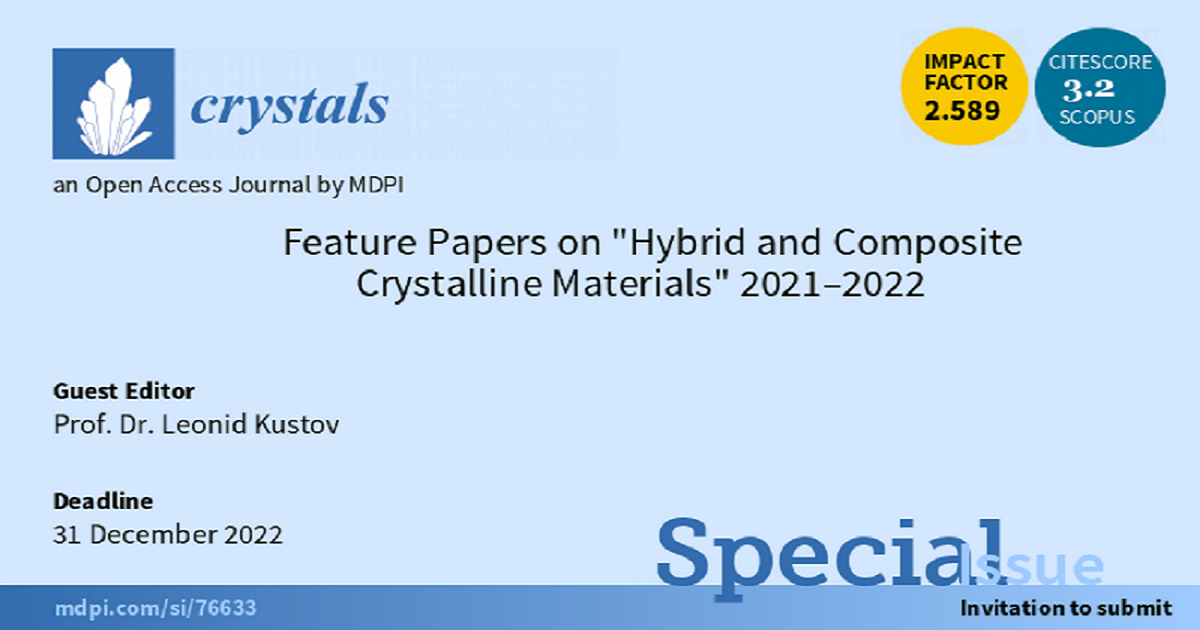Feature Papers on "Hybrid and Composite Crystalline Materials" 2021-2022
A special issue of Crystals (ISSN 2073-4352). This special issue belongs to the section "Hybrid and Composite Crystalline Materials".
Deadline for manuscript submissions: closed (31 December 2022) | Viewed by 73978

Special Issue Editor
2. Chemistry Department, Moscow State University, Leninskie Gory 1, Bldg. 3, 119992 Moscow, Russia
3. Institute of Ecology and Engineering, National Science and Technology University MISiS, Leninsky Prospect 4, 119071 Moscow, Russia
Interests: catalysis; nanomaterials; renewables; green chemistry
Special Issues, Collections and Topics in MDPI journals
Special Issue Information
Dear Colleague,
This Special Issue entitled “Feature Papers on ‘Hybrid and Composite Crystalline Materials’ 2021–2022” covers topics related to the chemistry and structure of diverse hybrid and composite crystalline materials, the design and engineering of these materials, and their applications. Hybrid and composite crystalline materials include, inter alia, coordination polymers; metal–organic frameworks; covalent organic frameworks; hierarchical zeolites and zeolite-like materials; organic–inorganic hybrids; composites based on graphene, carbon nitride, or layered sulfides; and composites based on metal, metal oxide, metal chalcogenide, or metal pnictide nanoparticles stabilized with organic ligands or polymers (such nanoparticles can be either unsupported or supported onto appropriate matrices). Other topics related to the design and application of hybrid and composite crystalline materials are welcome. For example, coordination chemistry, the influence of intermolecular interactions on the geometry and arrangement of species constituting hybrid and composite crystalline materials, and cooperative and synergistic effects will all be considered.
For this Special Issue, we aim to publish high-quality articles within the field of hybrid and composite crystalline materials. A discount on the article processing charge will be available for published papers. Please feel free to contact Jocelyn Bai ([email protected]) if you would like to contribute to this Special Issue.
Prof. Dr. Leonid Kustov
Guest Editor
Manuscript Submission Information
Manuscripts should be submitted online at www.mdpi.com by registering and logging in to this website. Once you are registered, click here to go to the submission form. Manuscripts can be submitted until the deadline. All submissions that pass pre-check are peer-reviewed. Accepted papers will be published continuously in the journal (as soon as accepted) and will be listed together on the special issue website. Research articles, review articles as well as short communications are invited. For planned papers, a title and short abstract (about 100 words) can be sent to the Editorial Office for announcement on this website.
Submitted manuscripts should not have been published previously, nor be under consideration for publication elsewhere (except conference proceedings papers). All manuscripts are thoroughly refereed through a single-blind peer-review process. A guide for authors and other relevant information for submission of manuscripts is available on the Instructions for Authors page. Crystals is an international peer-reviewed open access monthly journal published by MDPI.
Please visit the Instructions for Authors page before submitting a manuscript. The Article Processing Charge (APC) for publication in this open access journal is 2600 CHF (Swiss Francs). Submitted papers should be well formatted and use good English. Authors may use MDPI's English editing service prior to publication or during author revisions.
Keywords
- hybrid materials
- composite materials
- intermolecular interactions
- molecular crystals
- coordination polymers
- metal–organic frameworks
- covalent organic frameworks
- hierarchical zeolites
- zeolite-like materials
- organic–inorganic hybrids
- graphene
- carbon nitride
- layered sulfides
- metal nanoparticles
- metal oxide nanoparticles
- metal chalcogenide nanoparticles
- metal pnictide nanoparticles





